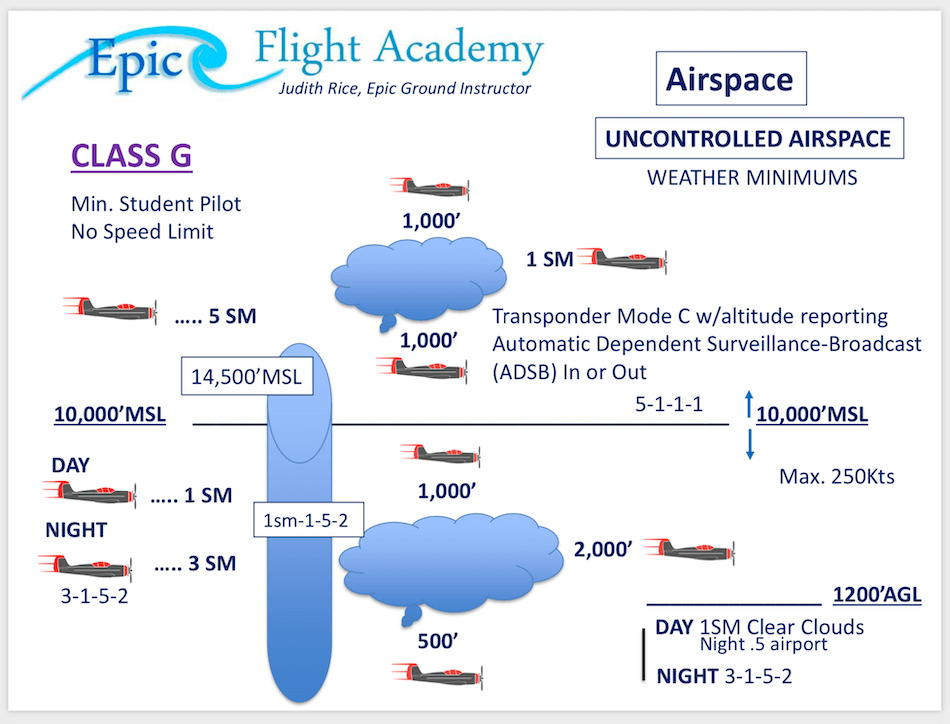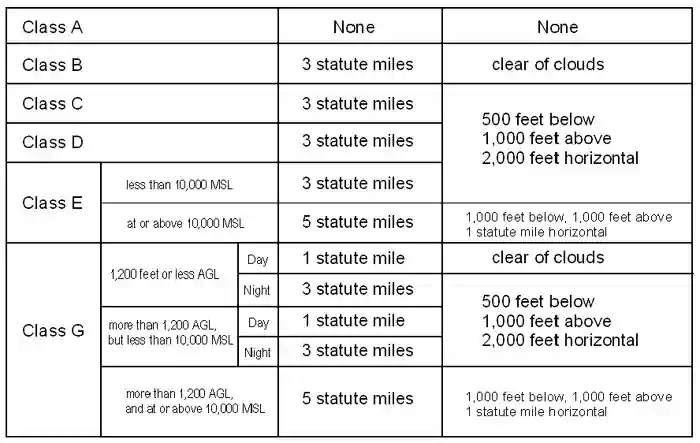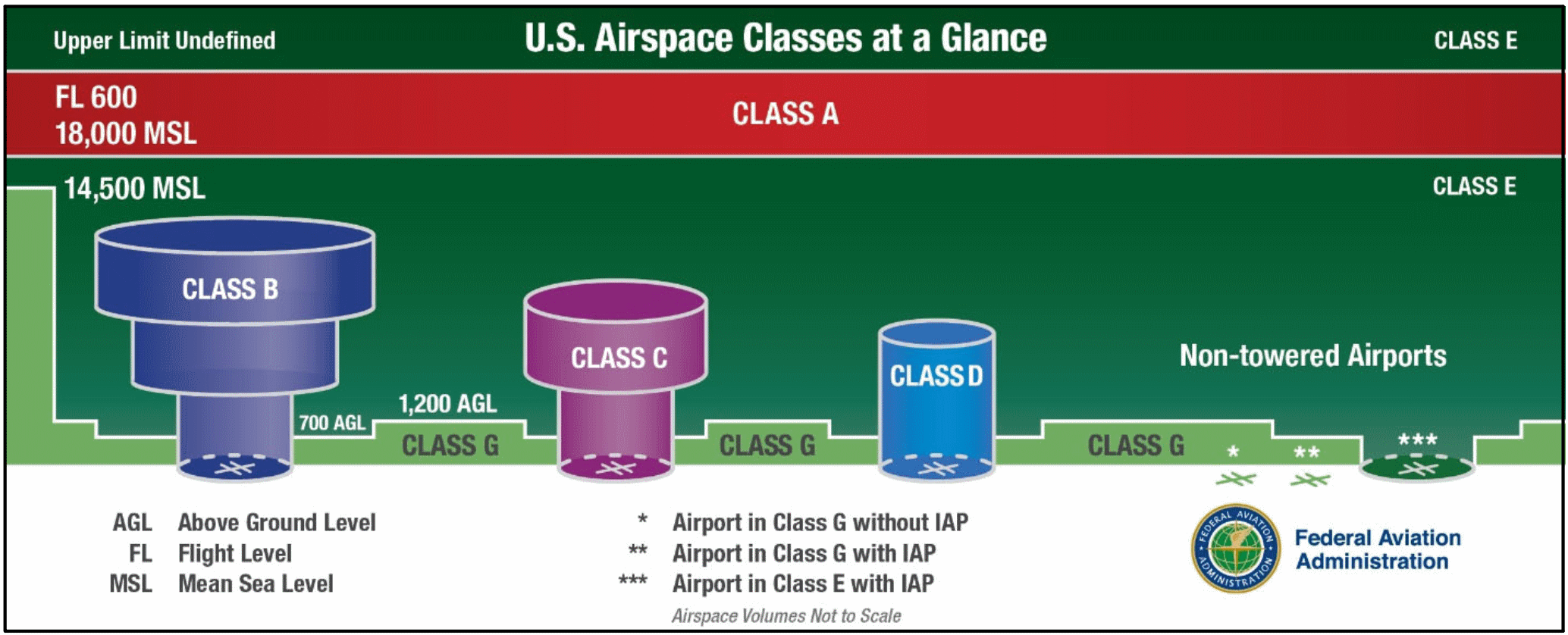class g airspace visibility requirements
500 Below 1000 Above 2000 Horizontal. 1 SM vis 500 below 1000 above 2000 horizontal.

Helicopter Instrument Procedures Part Three
Uncontrolled airspace is designated as Class G with areas having low volume of air traffic.

. 500 Below 1000 Above 2000 Horizontal 500 Below 1000 Above. VFR Minimum Distance from Clouds Below 10000 MSL. 135609 VFR ceiling and visibility requirements for Class G airspace.
36 rows Notwithstanding the provisions of paragraph a of this section the following operations may be conducted in Class G airspace below 1200 feet above the surface. Class G airspace uncontrolled is that portion of airspace that has not been designated as Class A Class B Class C Class D or Class E airspace. For aircraft other.
Related Article Class G Airspace Explained. 3 SM vis 500 below 1000 above 2000 horizontal. 12 rows 1200 feet or less above the surface regardless of MSL altitude 1 statute mile.
Minimum flight visibility and distance from clouds required for VFR flight are. Weather Requirements Class G minimum weather requirements exist so that you can see and avoid other aircraft and stay out of the clouds. 1200 ft AGL and 10000 ft MSL.
At night in Class G between 1200 AGL and 10000ft MSL the visibility and cloud clearance are the same as Class CD. Depending on how high you fly and the time of day within Class G airspace your visibility requirement could range anywhere from 1SM to 5SM. A helicopter may be operated clear of clouds in an airport traffic pattern within 12 mile of the runway or helipad of intended landing if the flight visibility is not less than 12 statute mile.
Day - 1 Statute Mile Night - 3 Statute Miles. B No person may operate a helicopter under VFR in Class G airspace at an altitude of 1200 feet or less above the surface or within the lateral boundaries of the surface areas of Class B Class C Class D or Class E airspace designated for an airport unless the visibility is at least - 1 During the day - 12 mile. The requirements are slightly less restrictive in Class G airspace with a less restrictive daytime visibility below 10000 feet MSL 1 statute mile only and below 1200 feet AGL by day a less-restrictive separation from clouds clear of clouds with no distance-from-cloud requirements.
Most air traffic in Class G fly under Visual Flight Rules VFR rules. 1200 ft AGL and 10000 ft MSL. Above 10000ft MSL the requirements are 5 SM visibility and cloud clearance of 1000ft above 1000ft below and 1 SM horizontally.
Day - 1 Statute Mile Night - 3 Statute Miles. 1 SM vis COC. Class G Airspace Cloud Clearance Visibility Requirements.
Also there are no communication or air traffic control requirements. There are moderate required VFR weather minimums. 500 Below 1000 Above 2000 Horizontal.
Or 2 At night - 1 mile. It is the pilots responsibility to see and avoid other traffic. 135609 VFR ceiling and visibility requirements for Class G airspace.
500 Below 1000 Above 2000 Horizontal. 3 SM vis 500 below 1000 above 2000 horizontal. On the other hand Class G airspace has four different sets of altitude-dependent minimums.
. A Unless otherwise specified in the certificate holders operations specifications when conducting VFR helicopter air ambulance operations in Class G airspace the weather minimums in the following table apply. At night requirements jump to three miles visibility and from merely clear of clouds to 500 feet below 2000 feet horizontal and.
VFR Minimum Visibility Below 10000 MSL. Notwithstanding the provisions of paragraph a of this section the following operations may be conducted in Class G airspace below 1200 feet above the surface. Rules governing VFR flight have been adopted to assist the pilot in meeting the responsibility to see and avoid other aircraft.
A helicopter may be operated clear of clouds in an airport traffic pattern within 12 mile of the runway or helipad of intended landing if the flight visibility is not less than 12 statute mile. Class G 1200 feet or less above the surface regardless of MSL altitude. A Unless otherwise specified in the certificate holders operations specifications when conducting VFR helicopter air ambulance operations in Class G airspace the weather minimums in the following table apply.
G night 3 statute miles 152 4500 below 41000 above 42000 horizontal G day 1 statute mile 152 4500 below 41000 above 42000 horizontal G night 3 statute miles 152 4500 below 41000 above 42000 horizontal G day 1 statute mile Clear of clouds Below 1200 AGL 1200 AGL or higher 3 statute miles 152 4500 below 41000 above 42000 horizontal Below 10000 MSL. In Class B airspace aircraft are required to remain clear of clouds. In the airspace highlighted below Class E starts at 1200 AGL so Class G automatically starts at the surface and extends to - but doesnt include - 1200 AGL.

Uncontrolled And Controlled Airspace

Vfr Cloud Clearances Pilot Training For Ga

Knowledge Requirements For Pilots Of Remotely Piloted Aircraft Systems 250 G Up To And Including 25 Kg Operating Within Visual Line Of Sight Vlos Tp 15263

Airspace Classes And Special Use Airspace Everything There Is To Know
Regulations Vfr Minimums Learn To Fly Blog Asa Aviation Supplies Academics Inc
What Are The Basic Vfr Minimums Quora
How To Remember Vfr Weather Minimums Bobbie Lind

Faa Airspace For Vfr Flight Youtube

Class G Airspace Explained Boldmethod
Helicopter Ground School Vfr Weather Minimums Rotorworks Inc

Class G Airspace Explained Boldmethod
How To Remember Vfr Weather Minimums Bobbie Lind

Uncontrolled And Controlled Airspace

What Are The Different Airspace Classes Flying Magazine

Why Are There Mandatory Cloud Clearance Requirements Boldmethod

